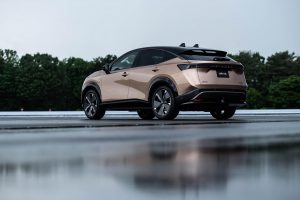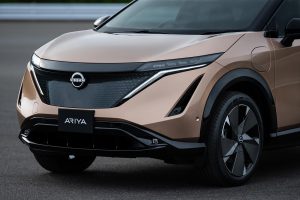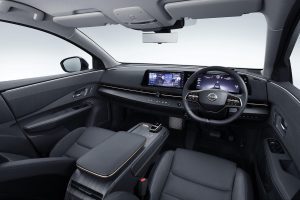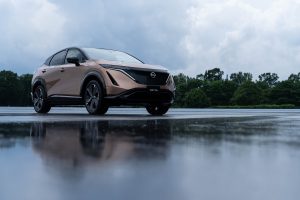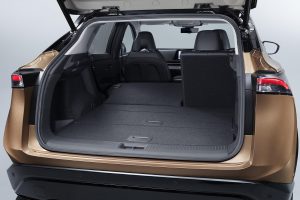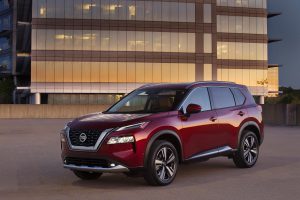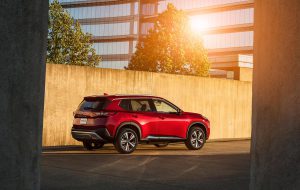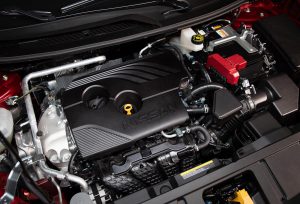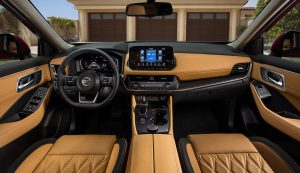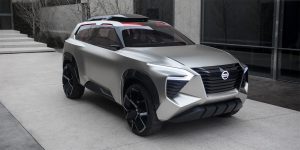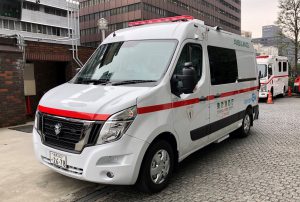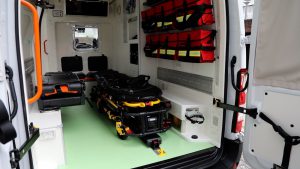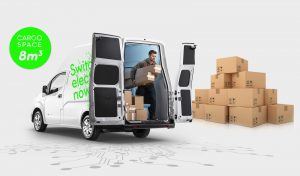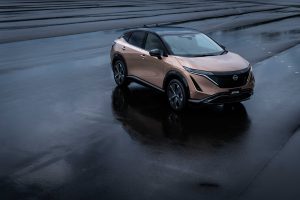
The 2021 Nissan Ariya is about the size of a Rogue SUV – but features the interior space of the bigger Murano.
Nissan is singing a new tune. With the arrival of the 2021 Ariya, Japan’s second-largest carmaker hopes to rebuild its once-lofty position as an innovator in the emerging market for battery-electric vehicles.
The automaker was, in fact, the first to mass market a BEV, but a decade after the launch of the original Leaf model, Nissan has not only been eclipsed by Tesla, but is being challenged by more conventional competitors, such as Volkswagen, Ford and General Motors, each rolling out waves of new long-range battery-cars.
The 2021 Nissan Ariya is the long-overdue battery-SUV meant to keep Nissan in the game. It’s a ground-up offering, not just a redesigned Leaf, with a brand-new platform and electric drive system that is more powerful and able to deliver longer range. Ariya also debuts Nissan’s first hands-free driving system.
(A week with the 2020 Nissan Leaf SL Plus.)
The new model “is the spearhead, showing our vision of the future,” said Ivan Espinosa, the carmaker’s senior vice president of global product planning, during a media roundtable ahead of the battery car’s Wednesday debut. “Ariya is not just an EV,” he emphasized. “It is showing the technical prowess of Nissan…what Nissan stands for.”
Pronounced like the song an opera diva sings, a concept version of the Ariya made its first appearance at the 2019 Tokyo Motor Show last autumn, followed by a U.S. debut at January’s Consumer Electronics Show in Las Vegas. Though there were some design details unique to exotic concepts, like the oversized wheels, the show car will go into production with only minor changes.
The 2021 Ariya rides on a flexible new architecture, Espinosa explained during the online meeting. It eventually will be used for a variety of battery-cars to be produced not only by Nissan but also by its two alliance partners, Japan’s Mitsubishi and France’s Renault.
(Nissan lifts the covers on the next-gen Rogue.)
“The beauty of this platform is it’s modular (which) allows us to accommodate different possibilities,” he said, adding that the three partners have “a lot of questions about what new areas of the market we can explore.”
As with key competitors like Tesla, Ford, GM and VW, the platform positions its batteries, motors and other key components below the load floor. That reduces the size of the traditional engine compartment, allowing significantly more freedom, said Nissan’s global styling chief Alfonso Albaisa. And the development team found other breakthrough strategies. Rather than mounting the climate control, or HVAC, system within the instrument panel, it was moved into the modest space left where an engine would normal go, freeing up more space for the passenger compartment.
“You get inside and you’re really shocked,” suggested Albaisa, pointing out that the exterior footprint of the Nissan Ariya is about as big as the subcompact Rogue SUV, but the cabin has the roominess of the much larger Murano.
(Nissan among automakers taking big sales hit in Q2.))
From an exterior design perspective, the Ariya is far less geeky than the Leaf which was designed during an era when green machines were expected to look like something from a sci-fi flick. That said, there are some obvious cues that tell you it’s a BEV, starting with absence of a conventional grille – electric vehicles needing far less disruptive airflow under the hood. Slit headlamps each feature four distinct LED bulbs. From the side, the crossover adapts a curvaceous, coupe-like shape, with plenty of subtle details designed to cheat the range-stealing wind – including twin rear spoilers.
Inside, Albaisa’s team adopted a minimalist approach, with a floating, horizontally oriented instrument panel featuring side-by-side video screens, each measuring 12.3 inches. One of the neat tricks is the ability to swipe across the infotainment display and move elements to the primary gauge display. The lack of a center tunnel creates a flat floor that makes it possible to sit five inside with reasonable comfort.
The new modular architecture is, fundamentally, front-wheel-drive, though buyers also will have the option of ordering an all-wheel-drive, twin-motor package. Nissan started all but from scratch, developing a new electric drive system it has dubbed e-4ORCE. The system has been described as the “spiritual offspring” of the automaker’s GT-R sports car, and that underscores a fundamental shift in thinking. No longer does Nissan believe BEV buyers will sacrifice that fun-to-drive quality just to go green.
The front-drive system delivers 160 kilowatts, or about 214 horsepower, and 221 pound-feet of torque. The twin-motor AWD system bumps that up to 290 kW, or 389 hp, and 443 lb-ft. The e-4ORCE system can direct power to individual wheels, using torque to assist driver input, among other things, when tracking through a corner.
That also pays off when using the next-generation ProPilot Assist 2.0, Nissan’s semi-autonomous driving system. The original version could help center the vehicle in its lane, among other things, but required drivers to keep hands on the wheel at all times. The new system, Nissan explained, allows “attentive drivers to take their hands off the steering wheel under certain conditions.”
Specific details have yet to be released but it appears to follow the format of GM’s Super Cruise and Ford’s new version of CoPilot 360, operating on limited-access roads mapped in high-resolution. A monitoring system makes sure a driver remains alert and ready to take control in an emergency.
In terms of batteries, Nissan has continued tinkering with the chemistry of its lithium-ion cells and has both cut their cost and increased their energy density, storing more power in less space. The base 2021 Ariya stores 63 kilowatt-hours. That’s within a kWh of the current, longest-range version of the gen-2 Nissan Leaf Plus. The Ariya offers an extended-range 87 kWh battery expected to get around 300 miles per charge, according to the EPA.
As for charging, Nissan officials weren’t ready to offer details beyond noting Ariya can handle up to 137 kilowatts of power, a big jump up from the roughly 50 kW limit for Leaf. That would suggest an 80% recharge for the smaller pack in perhaps a bit over an hour at a CCS charger.
And that signals another big shift by the automaker which had been the only key player in the U.S. market committed to the older, slower CHAdeMO system. Nissan’s policy “is to have happy customers,” said Espinosa,” and with more – and faster — CCS chargers now available, the switch was overdue, according to EV analysts.
As for pricing, the base version of the 2021 Nissan Ariya will start at $40,000, said Espinosa. It is set to go on sale in Japan in the coming weeks, with U.S. dealers beginning deliveries “later in 2021.”
For the first half of the past decade, Nissan dominated EV sales charts. It has lost its lead to Tesla and is facing plenty of other competition going forward. Whether it can come close to being a significant player with Ariya is far from certain. But Nissan officials are betting that the new BEV has enough going for it to make Ariya a serious contender.
(Ford’s Bronco is back…and it’s now part of a new family of SUVs.)
